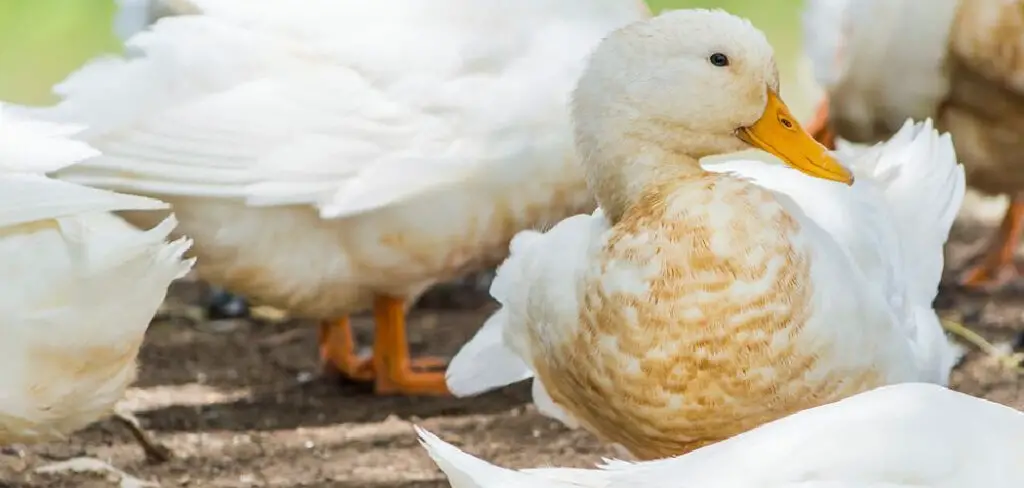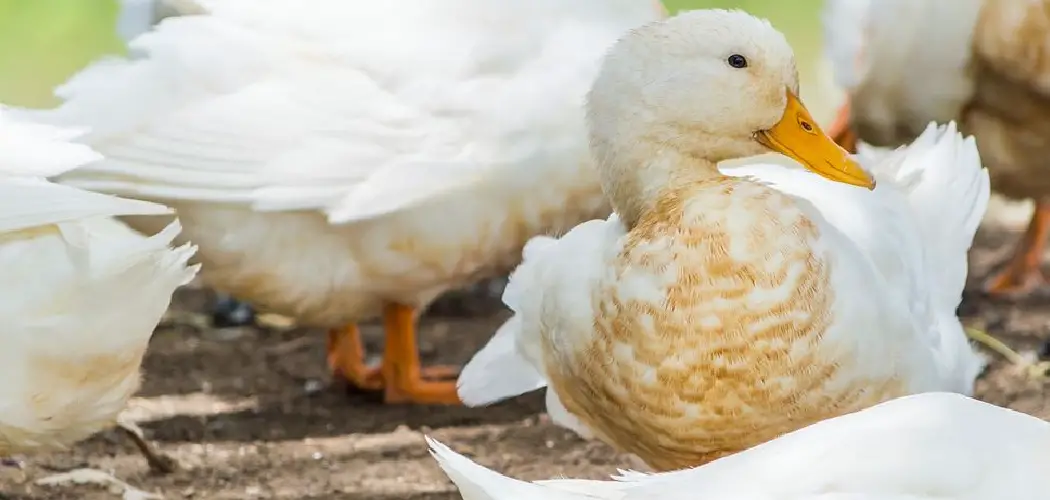Determining the gender of Pekin ducklings can be a bit tricky, but it’s essential for managing your flock and planning for the future. This guide will explore how to tell male from female pekin ducklings, including physical characteristics, behavior, and vocalizations.

By learning these distinguishing features, you’ll be able to confidently identify the sex of your ducklings, ensuring you provide the best care and environment for each one.
Importance of Determining the Gender of Pekin Ducklings
Understanding the gender of your Pekin ducklings is crucial for several reasons. Firstly, it allows you to maintain a balanced and healthy flock. Male to female ratios can significantly impact the group’s social dynamics, with too many males leading to aggressive behavior and potential harm to females.
Secondly, knowing the gender is important for breeding purposes. Identifying the sexes early on helps in planning selective breeding and ensuring genetic diversity. Lastly, the specific needs of males and females can differ slightly in terms of diet and care. By recognizing these differences, you can provide tailored nutrition and management practices, promoting the overall well-being of your ducklings.
Differences in Size and Growth Rate
One of the most noticeable differences between male and female Pekin ducklings is their size and growth rate. Generally, male Pekin ducklings tend to grow larger and heavier than their female counterparts. This size disparity becomes evident as early as a few weeks old. Male ducklings typically exhibit faster growth rates, often requiring more food to sustain their increased energy needs.
By the time they reach maturity, males can weigh significantly more than females, and their bodies appear more robust and muscular. Monitoring these growth patterns can provide valuable clues in determining the gender of your ducklings, aiding in their effective management and care.
Social Interactions and Dominance Behaviors
Social interactions and dominance behaviors are key indicators of gender in Pekin ducklings. Males often display more assertive and dominant behaviors compared to females. You may notice male ducklings engaging in more frequent bouts of chasing, pecking, and other forms of playful aggression as they assert their dominance within the group.

This behavior helps establish a social hierarchy, which is essential for the smooth functioning of the flock. Additionally, male ducklings might display protective behaviors, such as standing guard while the females forage. These social cues, when observed over time, can help differentiate males from females, contributing to the overall harmony and well-being of your flock.
10 Methods How to Tell Male from Female Pekin Ducklings
1. Vent Sexing
Vent sexing is the most accurate method to determine the sex of Pekin ducklings, but it requires experience and care. This technique involves gently everting the duckling’s cloaca to examine the genitalia. Male ducklings have a small, pointed phallus, while females do not. To perform vent sexing, hold the duckling securely but gently, and use a clean, moist cotton swab to press around the vent area to expose the internal structures. This method should only be attempted by someone with proper training, as improper handling can harm the duckling.
2. Behavioral Observation
Observing the behavior of Pekin ducklings can provide clues about their sex. Male ducklings tend to be more assertive and aggressive, often dominating over food and space. They may display more curiosity and boldness, exploring their environment more vigorously.
Females, on the other hand, are typically more submissive and social, often sticking together in groups. While behavioral differences are subtle and not foolproof, consistent observation over time can help identify patterns that indicate the ducklings’ sex.
3. Feather Growth and Patterns
Feather growth and patterns can sometimes indicate the sex of Pekin ducklings. Female ducklings generally feather out more quickly than males. By the time they are a few weeks old, females might have more developed feathers, particularly on their wings and tails. Male ducklings might appear more downy for a longer period. This method is not entirely reliable on its own but can be used in conjunction with other indicators to make a more educated guess.

4. Vocalizations
Listening to the vocalizations of Pekin ducklings can help determine their sex. As they mature, females develop a louder, more distinct quack, while males have a softer, raspier sound. Around 4-6 weeks of age, you can start to hear these differences. Holding each duckling and listening closely to their sounds can help you distinguish between the sexes. Keep in mind that environmental factors and the ducklings’ comfort levels can affect vocalizations, so multiple observations may be necessary.
5. Size and Growth Rate
Male Pekin ducklings often grow larger and faster than females. By comparing the size and weight of ducklings of the same age, you might be able to identify males based on their more robust build. Males typically have broader chests and more substantial legs. Tracking the growth rates of individual ducklings over several weeks can provide additional insight. However, genetic and environmental factors can influence growth, so this method should be used alongside other techniques.
6. Tail Feather Development
The development of tail feathers can also provide clues about the sex of Pekin ducklings. Males may develop curly tail feathers, known as drake feathers, as they mature. These feathers start to appear around 8-12 weeks of age and are a clear indicator of a male duck. Females have straight, smooth tail feathers. While this method requires waiting until the ducklings are older, it is a reliable way to confirm the sex of your ducks.

7. Wing Sexing
Wing sexing involves examining the primary feathers on the wings of the ducklings. Female ducklings often have more uniform and evenly spaced primary feathers, while males may have longer and more pointed feathers. This method is not as commonly used and can be less reliable than vent sexing or vocalization analysis, but it can provide additional information when combined with other methods.
8. Cloacal Examinations at Different Ages
Performing cloacal examinations at different ages can improve accuracy. As ducklings grow, the differences in their reproductive organs become more pronounced.
Conducting a vent sexing examination at 1 day old, again at 1 week old, and then at 3 weeks old can help you track the development of their genitalia and confirm their sex with greater confidence. This approach requires consistent monitoring and experience but can provide more reliable results.
9. Behavioral Differences During Mating Season
As Pekin ducks approach sexual maturity, their behaviors during the mating season can indicate their sex. Males become more territorial and may display courtship behaviors such as head bobbing, tail wagging, and chasing females. Females, conversely, may exhibit submissive behaviors and nest-building activities. Observing these behaviors as the ducks reach 16-24 weeks of age can help confirm their sex, though this method requires patience and may not be applicable for early identification.
10. Combining Multiple Methods
The most reliable way to determine the sex of Pekin ducklings is to combine multiple methods. By integrating observations of behavior, vocalizations, feather patterns, size, and vent examinations, you can cross-reference the information to make a more accurate determination.
This holistic approach minimizes the risk of error associated with any single method. Keeping detailed records of each duckling’s development and characteristics can aid in this comprehensive assessment, ensuring that you accurately identify the sex of your ducks.

Things to Consider When Sexing Pekin Ducklings
When attempting to sex Pekin ducklings, there are several important factors to keep in mind to ensure accuracy and the well-being of the ducklings.
1. Handling with Care
Sexing techniques, especially those involving physical examination like vent sexing or cloacal examinations, require gentle and careful handling to avoid causing injury or stress to the ducklings. It’s crucial to be patient and use appropriate techniques, ensuring that each procedure is performed as humanely as possible.
2. Training and Experience
Some methods, such as vent sexing, require specific training and practice to perform correctly. Inexperienced handlers may struggle to identify the subtle differences in genitalia or inadvertently harm the ducklings. It’s advisable to seek guidance from a professional or experienced individual before attempting this on your own.
3. Age of Ducklings
The age of the ducklings can significantly impact the effectiveness of certain sexing methods. For example, vocalization differences become more pronounced around 4-6 weeks of age, while drake feathers appear at 8-12 weeks. Timing your observations and examinations according to these developmental stages is crucial for accurate results.
4. Combining Methods
Relying on a single method can lead to incorrect sexing results. Combining multiple techniques, as mentioned earlier, increases the reliability of your conclusions. Observing behaviour, feather growth, size, and vocalizations together provide a more comprehensive understanding of each duckling’s sex.
5. Environmental Factors
Environmental conditions can influence the behaviour and growth patterns of ducklings, potentially affecting the accuracy of some sexing methods. Ensuring that your ducklings are in a stable, stress-free environment can help reduce variables that might complicate sexing efforts.
Conclusion
Each of these methods provides valuable insights into the sex of Pekin ducklings, but they are most effective when used in combination. Patience, careful observation, and consistent monitoring are key to accurately determining the sex of your ducklings. By applying these techniques thoughtfully and cross-referencing the information, you can confidently identify male and female Pekin ducklings, ensuring proper care and management of your flock. Thanks for reading, and we hope this has given you some inspiration on how to tell male from female pekin ducklings!
Check it out to Keep Birds Out of Your Garage
About
Outdoor Fixes is a distinguished figure in the world of Diy design, with a decade of expertise creating innovative and sustainable Diy solutions.
His professional focus lies in merging traditional craftsmanship with modern manufacturing techniques,
fostering designs that are both practical and environmentally conscious. As the author of diy,
outdoorfixes delves into the art and science of outdoorfixes-making, inspiring artisans and industry professionals alike.
Education RMIT University
(Melbourne, Australia) Associate Degree in Design (Outdoor Fixes) Focus on sustainable design, industry-driven projects,
and practical craftsmanship. Gained hands-on experience with traditional and digital manufacturing tools, such as CAD and CNC software.
Nottingham Trent University
(United Kingdom) Bachelor’s in outdoorfixes.com and Product Design (Honors) Specialized in product design with a focus on blending creativity with production
techniques. Participated in industry projects, working with companies like John Lewis and Vitsoe to gain real-world insights.
Publications and Impact
In diy, Outdoor Fixes his insights on indoor design processes, materials, and strategies for efficient production.
His writing bridges the gap between artisan knowledge and modern industry needs, making it a must-read for both budding designers and seasoned professionals.

